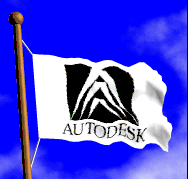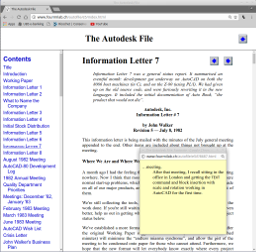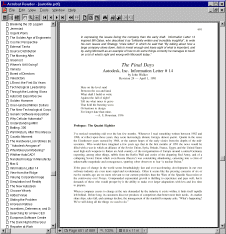
The Autodesk File
Bits of History, Words of Experience
Edited by
John Walker
Fifth Edition, 2017
The Autodesk File chronicles the history of Autodesk, Inc.
and its principal product, AutoCAD,
through contemporary documents edited and annotated
by Autodesk founder and former CEO John Walker.
The book traces the company from the first glimmer of an idea in the
minds of the founders, through start-up, initial public stock
offering, and growth from a loose confederation of moonlighting
individuals to a leader in the industry of computer aided design.
The book is available in several different editions, suited
for on- or off-line reading with various tools. Click on
the titles of the section describing the edition you prefer
to view it or download to your computer.
 The Fifth Edition (2017) of The Autodesk File was prepared to
commemorate the thirty-fifth anniversary of the founding of Autodesk
in 1982. Except for correction of a few typographical errors, the
content is identical to that of the 1994 fourth edition, but the
book has been entirely reformatted and updated to contemporary
Web standards. The typography uses Unicode text entities, and should
be much easier on the eye. Each chapter is now a single document,
instead of being broken into sections and subsections, and easier
to read without incessant clicking on navigation buttons. All of
the AutoCAD sample drawings used as illustrations have been
re-made from their original PostScript plot files with higher
resolution. The pop-up windows for footnotes (which were irritating
and ran afoul of some browser pop-up blockers) have been replaced by
icons which display the footnote when clicked. Cross-references
are indicated by an
The Fifth Edition (2017) of The Autodesk File was prepared to
commemorate the thirty-fifth anniversary of the founding of Autodesk
in 1982. Except for correction of a few typographical errors, the
content is identical to that of the 1994 fourth edition, but the
book has been entirely reformatted and updated to contemporary
Web standards. The typography uses Unicode text entities, and should
be much easier on the eye. Each chapter is now a single document,
instead of being broken into sections and subsections, and easier
to read without incessant clicking on navigation buttons. All of
the AutoCAD sample drawings used as illustrations have been
re-made from their original PostScript plot files with higher
resolution. The pop-up windows for footnotes (which were irritating
and ran afoul of some browser pop-up blockers) have been replaced by
icons which display the footnote when clicked. Cross-references
are indicated by an
![[Ref]](e5/i/xref.png) icon which navigates to the cited page when clicked. A navigation
bar at the left provides instant access to all chapters, and
highlights the current chapter regardless of how you arrived there.
The Fifth Edition is compatible with
most modern desktop browsers. The Safari browser on iOS mobile devices
(iPad, iPhone) has a serious flaw in scrolling text within a
window which has remained uncorrected for years. On these devices,
you can read the
iOS work-around edition,
which contains a device-specific fix for the problem.
icon which navigates to the cited page when clicked. A navigation
bar at the left provides instant access to all chapters, and
highlights the current chapter regardless of how you arrived there.
The Fifth Edition is compatible with
most modern desktop browsers. The Safari browser on iOS mobile devices
(iPad, iPhone) has a serious flaw in scrolling text within a
window which has remained uncorrected for years. On these devices,
you can read the
iOS work-around edition,
which contains a device-specific fix for the problem.
For older browsers which which support frames, this
edition allows navigation through the book with
a panel which lets you click chapter titles and go
directly to that chapter. If, in addition, your browser
supports JavaScript, simply moving the mouse over a
footnote icon, like this one:
![[Footnote]](www/i/foot.gif) will pop up a window containing the footnote. Moving the
mouse over other footnotes displays them in the auxiliary window.
Browsers without JavaScript (or users who have disabled
JavaScript in their browsers) may display footnotes in
the main document window by clicking the footnote icon,
then use their browser's “Back” button to return to the
main text. Users with more modern browers will find the
Fifth Edition easier to read and
navigate.
will pop up a window containing the footnote. Moving the
mouse over other footnotes displays them in the auxiliary window.
Browsers without JavaScript (or users who have disabled
JavaScript in their browsers) may display footnotes in
the main document window by clicking the footnote icon,
then use their browser's “Back” button to return to the
main text. Users with more modern browers will find the
Fifth Edition easier to read and
navigate.
 Users with browsers which do not support frames, or those
who prefer a more linear presentation in a single
window, may access a no-frame edition of The Autodesk
File with identical content to the frame-based book.
The no-frame edition includes the pop-up footnotes present
in the frame edition, but since few browsers which lack
frames are likely to support JavaScript, you can simply click
on the footnote icon to display it, then use the
“Back” button or keystroke to return to the text containing
the footnote.
Users with browsers which do not support frames, or those
who prefer a more linear presentation in a single
window, may access a no-frame edition of The Autodesk
File with identical content to the frame-based book.
The no-frame edition includes the pop-up footnotes present
in the frame edition, but since few browsers which lack
frames are likely to support JavaScript, you can simply click
on the footnote icon to display it, then use the
“Back” button or keystroke to return to the text containing
the footnote.
 If you prefer to read the book off-line, you can
download a PDF edition (5.8 Mb, ZIP compressed)
which you
can read with the Adobe Acrobat Reader utility,
available for most personal computers and Unix workstations,
which may be
downloaded
free of charge directly from the
Adobe Systems Web site.
The Acrobat PDF edition preserves all the formatting of
the original book, some of which was lost in creating
the Web editions, and permits point-and-click navigation
among chapters and to follow cross-references in the text.
If you prefer to read the book off-line, you can
download a PDF edition (5.8 Mb, ZIP compressed)
which you
can read with the Adobe Acrobat Reader utility,
available for most personal computers and Unix workstations,
which may be
downloaded
free of charge directly from the
Adobe Systems Web site.
The Acrobat PDF edition preserves all the formatting of
the original book, some of which was lost in creating
the Web editions, and permits point-and-click navigation
among chapters and to follow cross-references in the text.
Adobe is one of the most consistently irritating companies
on Earth with which to do business. I'd like to give you
a nice button for downloading your own copy of Acrobat Reader,
but they won't let me use the image without “registering”
and “licensing” it, which I'm certainly not going to do
in order to promote their product and its file format.
The Autodesk File was originally typeset
using TeX with the
LaTeX macro package. Camera-ready copy was generated
from PostScript created by the dvips
utility. The PostScript edition is a single monolithic
file, more than 16 megabytes, containing the
entire book as originally typeset. You can read it on-line
with a PostScript viewing program such as
GhostScript
(which is free), or print it on any PostScript-compatible
printer. Before sending this
file to a printer, consider that the book is almost
900 pages long! This is a big print
job, which will consume lots of paper, toner, and,
potentially, good will of any colleagues with whom
you share the printer. The PostScript edition may be
downloaded as either a ZIPped archive
or a gzip compressed PostScript
file; both are 4.9 Mb in length and uncompress to a 16
Mb PostScript file.
by John Walker
 The Fifth Edition (2017) of The Autodesk File was prepared to
commemorate the thirty-fifth anniversary of the founding of Autodesk
in 1982. Except for correction of a few typographical errors, the
content is identical to that of the 1994 fourth edition, but the
book has been entirely reformatted and updated to contemporary
Web standards. The typography uses Unicode text entities, and should
be much easier on the eye. Each chapter is now a single document,
instead of being broken into sections and subsections, and easier
to read without incessant clicking on navigation buttons. All of
the AutoCAD sample drawings used as illustrations have been
re-made from their original PostScript plot files with higher
resolution. The pop-up windows for footnotes (which were irritating
and ran afoul of some browser pop-up blockers) have been replaced by
The Fifth Edition (2017) of The Autodesk File was prepared to
commemorate the thirty-fifth anniversary of the founding of Autodesk
in 1982. Except for correction of a few typographical errors, the
content is identical to that of the 1994 fourth edition, but the
book has been entirely reformatted and updated to contemporary
Web standards. The typography uses Unicode text entities, and should
be much easier on the eye. Each chapter is now a single document,
instead of being broken into sections and subsections, and easier
to read without incessant clicking on navigation buttons. All of
the AutoCAD sample drawings used as illustrations have been
re-made from their original PostScript plot files with higher
resolution. The pop-up windows for footnotes (which were irritating
and ran afoul of some browser pop-up blockers) have been replaced by

